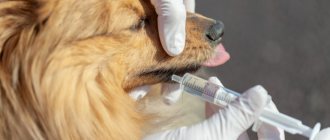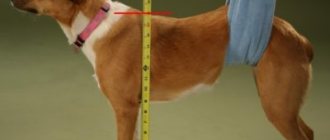This inflammatory process is considered a serious disease and often leads to thrombosis, as well as sepsis (blood poisoning). The difference from other similar diseases is that phlegmon in dogs does not contain precise signs. The disease is formed in most cases due to the entry of purulent bacteria into the matter.
How can you catch cellulitis?
In exceptional cases, a specific chemical influence can cause the disease. However, inflammation does not always occur for these reasons. For example, when you walk your dog, it may accidentally injure itself or get into fights with other dogs.
As a result of the injuries received, a large number of pyogenic microflora, for example, Staphylococcus aureus, can enter the affected area. Much attention should be paid to small wounds; you should not think that they will heal on their own. After all, a seemingly small bite often leads to serious consequences.
Every owner will be interested in the question, why do these complications occur? In the area of a small bite, a sufficient cavity is formed, where suitable conditions are formed for the occurrence of inflammatory processes. Therefore, if you notice in time that your dog has a wound, it is better to immediately contact a veterinarian to provide qualified assistance. Every dog owner should know that properly provided assistance can prevent the appearance and development of phlegmon.
Symptoms of the disease
At the first stage of development, severe swelling forms. Touching this area activates very severe pain in the dog. As the disease progresses, dogs become less active. In addition, breathing and heart rate noticeably accelerate. As a result of the disease, a complete or slight decrease in appetite can be observed. At the most late stages of formation, tissue necrosis can be observed.
During the development of the disease, complete intoxication occurs, since the number of neutrophils in the blood increases, which indicate an increase and change in the cellular composition of the blood. It will not be possible to establish a clear diagnosis of the disease in everyday circumstances, since a puncture is required, which means that the help of a veterinarian is mandatory.
Let's look at the main symptoms of phlegmon in a dog, and if they appear, you should immediately contact the clinic:
- Hot and reddened bulge in the subcutaneous tissue.
- Decreased appetite.
- Apathetic state.
- Reluctance to move, jump.
- Every movement causes suffering.
- Rapid increase in body temperature.
Be sure to tell the veterinarian about the animal’s behavior and condition so that he can make an accurate diagnosis. During the examination, the doctor must establish the presence of suppuration. You also cannot do without blood tests to detect the total number of leukocytes. When there is a possibility of a hostile neoplasm (sarcoma), a biopsy with further examination of the painful material is needed.
Prevention
The formation of phlegmon in a dog can be prevented by following preventive measures:
- Open injuries should be immediately washed with a solution of hydrogen peroxide; large injuries should preferably be treated in a veterinary clinic;
- It is recommended to feed your pet a balanced diet with vitamin and mineral supplements;
- It is advisable to immediately treat all infectious and non-infectious diseases of the pet;
- Once a year, it is necessary to carry out preventive examinations of the dog in a veterinary clinic with laboratory testing of urine and blood tests;
- At the first symptoms of the disease, you should immediately consult a specialist.
Cellulitis in dogs is a very serious and deadly pathology; the prognosis of the disease directly depends on the timely contact of the dog owner to specialists.
Causes of appearance and preventive measures
The cause is considered to be anaerobic and putrefactive microflora and the penetration of pathogenic microorganisms into the scratch. The causative agents are usually considered to be streptococci and staphylococci. The spread of inflammation directly depends on the decrease in immunity initiated by exhaustion, prolonged illness, and intoxication.
The most severe forms of the disease appear under the influence of abundant anaerobes that multiply without oxygen. There are anaerobic, purulent and putrefactive phlegmon. Anaerobic manifestations are characterized by serous inflammation and necrosis of soft tissues, and the formation of blisters.
Putrefactive phlegmon in a dog involves necrosis of numerous areas of tissue, melting of tissue, abundant accumulation of pus and a foul odor. Also, inflammation can progress against the background of the subsequent spread of some primary purulent process, for example, with advanced forms or improperly treated abscesses, boils, carbuncles.
As preventive measures, it is recommended to carry out several medical measures: compliance with the rules of disinfection and prevention of wound suppuration;
- timely processing;
- prevention of microtraumas;
- timely treatment of local sources of infection.
What causes phlegmon, reasons
The reason for the development of phlegmon is the penetration, active development and spread of infection. As a result, a purulent melting of tissues (fat, muscle, etc.) is formed with damage to nearby organs (vessel walls, intestines, kidneys, etc.). Cellulitis is usually caused by bacteria: more often aerobic, such as streptococci, Staphylococcus aureus, etc., less often by anaerobes (forming spores).
Other factors that influence the development of phlegmon:
- the presence of chronic intoxication due to chronic inflammation, poisoning, chemotherapy, radiation sickness,
- extensive severe injuries,
- patient's immune status,
- virulence of bacteria (ability to cause disease).
Bacteria can enter through a scratch, insect bite, or injury to form a cellulitis just under the skin. They can also move with the blood flow from an inflamed organ (abscess of the kidney, lung, liver, appendiceal abscess, perirectal abscess, etc.).
The bacteria can also attach to the wall of an internal organ, such as the stomach wall or appendix, and form a cellulitis.
People with weakened immune systems may be especially vulnerable to cellulitis formation.
Symptoms and manifestations of phlegmon
Vary depending on the location and severity of the infection. The main symptoms are redness of the skin and swelling at the site of inflammation.
Soft tissue phlegmon against the background of a progressive abscess
The affected part of the body is sensitive to touch and hurts. Fever is later added to this symptom. Swollen associated lymph nodes may occur.
Manifestations of skin phlegmon
- skin redness
- inflammation
- pale swelling of tissues
- swollen lymph nodes
- elevated local temperature
- fatigue
- fever
- headache
Internal organs
Cellulitis can affect any internal organ. Symptoms may vary depending on the organ and the specific bacteria.
- organ dysfunction
- abdominal pain
- fever
- chills
- nausea
- vomit
- diarrhea
- intestinal obstruction
- elevated body temperature
- loss of appetite
- increased thirst
- sweating
- increase in white blood cells (leukocytosis)
How to properly treat cellulitis in dogs
In the development of phlegmon, there are a number of stages for which proper treatment methods have been invented. Treatment of phlegmon in a dog is based on stopping the inflammatory process and cleansing the source of damage.
- Stage 1 - swelling with inflammation forms.
- Stage 2 - a cellular barrier is created.
- Stage 3 - accumulation of pus limited by the capsule occurs, necrosis progresses.
- Stage 4 - the formation of abscesses ends, inflammation has formed.
- Stage 5 is the stage of the complex granulation process.
- Stage 6 - scar formation occurs.
At stages I–III, novocaine blockades are performed for treatment, and medications with novocaine are injected. At stages II–V, substances are determined to strengthen and normalize the functioning of the heart. At stages II–III, when the area is severely swollen, skin incisions are made to remove exudate. The incisions are covered with alcohol lotions with furatsilin solution. At stage IV, dead tissue is removed. The procedure is performed under general anesthesia or using sedatives and novocaine anesthesia. Large incisions are made to allow the fluid to escape. The wound is powdered with disinfecting powders, and applications of balsamic liniment (Vishnevsky ointment) are applied.
When scars form, it is effective to use an immunomodulator of bacterial origin to resolve them.
When there are doubts regarding the presence of a purulent inflammatory process, it is necessary to visit a veterinarian, because suppuration is dangerous due to the maturation of a septic condition and surgical intervention will be necessary for cure. Medical blood parameters should be assessed and systemic antibacterial medications should be prescribed.
Content
1. Types of abscess on a dog’s paw 2. Causes of occurrence 3. Symptoms 4. Treatment 5. Preventive measures
An abscess on a dog’s paw is a phenomenon that can be encountered quite often. Moreover, the intensity and complexity of the manifestations does not depend at all on the breed of the dog, its size, weight and even age. Every pet is potentially susceptible to this very unpleasant and sometimes downright dangerous disease.
Moreover, the size of the affected area itself can vary over a wide range, from a small “bead” to a “chicken’s egg”. Interesting. That the border of the abscess is clearly visible and separated by a red line. It is important to understand that purulent formations can appear not only on the paws (although this is the most common case), but also in other places - the torso, head, even on the tail. But the worst thing is if an abscess appears on the internal organs.
Should I self-medicate?
And self-medication can cause a dangerous condition. When the process of inflammation occurs in an acute form and rapidly spreads to the surrounding tissue, such a phlegmon is called diffuse.
In case of diffuse phlegmon, the animal should be provided with timely medical assistance. Otherwise, extensive necrosis of the skin and underlying tissues, blood poisoning and death of the animal can occur. If signs of intoxication increase and there is a lack of positive results, urgent surgical intervention is indicated.
A sick animal is released from work, placed in a clean room, and poultices and warming compresses are used during the first 1-3 days. Prevention of phlegmon consists of preventing injuries and providing timely first aid.
Currently reading:
- Thyroid dysfunction in dogs (hypothyroidism)
- What to do if your dog has an abnormal bite
- What do tumors on a dog's body and tail mean?
- Seven Signs and Remedies for Getting Rid of Fleas in Dogs
Diagnosis and treatment
To make a correct diagnosis, the dog owner must inform the veterinarian about recent injuries, fights, surgeries, and long-term illnesses of the pet. The decisive diagnostic value is puncture of the inflamed area with the release of pus.
To determine the cause of the pathology and the general condition of the four-legged patient, laboratory tests of urine and blood tests are prescribed.
Treatment of pathology is aimed at destroying pathogenic microflora and restoring the animal’s body after severe intoxication.
The initial stages of the disease are treated conservatively with the use of warm compresses, novocaine blockades, antibiotic therapy, alcohol dressings with ichthyol and camphor oil.
Necrotic lesions must be surgically removed in a veterinary clinic with complete excision of dead tissue and postoperative wound treatment. To relieve intoxication, cardiovascular drugs, drip infusions of sterile physiological solutions, antibacterial, immunostimulating drugs and vitamins are used.











